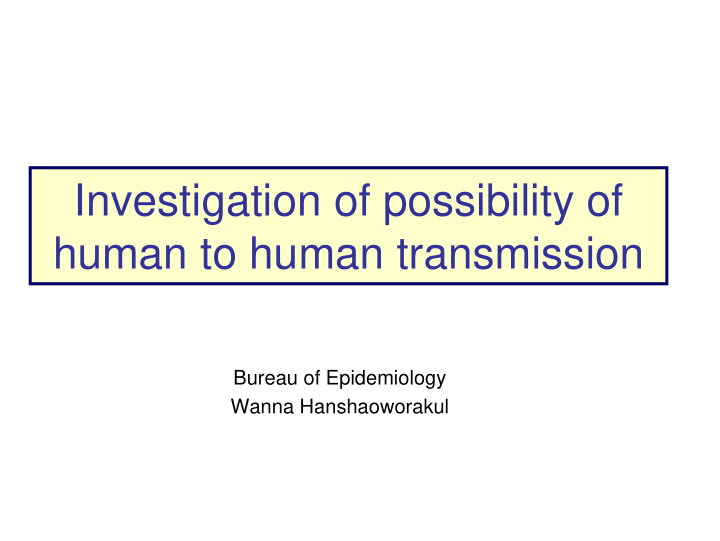



Investigation of possibility of human to human transmission Bureau of Epidemiology Wanna Hanshaoworakul
WHY? cluster investigation
Mathematic model for H5N1 transmission without control measure in Thailand 4 3 30 days 90 days 120 days 60 days 1 2 6 5 180 days 150 days Infected not transmit After infection Infected and transmit
Effect of intervention in containing outbreak at the source
Model summary • Antiviral prophylaxis can contain the epidemic when � R 0 < 1.6 � Intervention have to start within 21 days after onset of the first case • Other intervention such as isolation, limit the travel will accelerate the success
Signal for phase 4 4 Signal for phase • cluster of five closely related cases (including the index case) in which H-H transmission is suspected • Pneumonia of 3 cases in the same • Epidemiological signal place or join same activities and at least one has severe respiratory symptom • Virological signal • Detection of a virus with new genetic and antigenic feature • Isolation of a virus from a human case showing a number of mutations not seen in avian isolates Source:WHO pandemic influenza draft protocol for rapid response and contatinment
Evidence of mammal to mammal transmission
Experimental demonstrate cat to cat H5N1 transmission These results show that domestic CATs are at risk of disease or death from H 5 N 1 virus , can be infected by horizontal transmission , and may play a role in the epidemiology of this virus
Tiger zoo outbreak • A tiger zoo in Sriracha, Chonburi, Thailand, was affected by HPAI beginning on October 11, 2004. • On October 16, 2004, the tigers were fed cooked chicken carcasses or pork. • Four weeks after the last tiger was infected, 58 serum from all humans contacted with either the animals or their tissue or fluid. Seroconversion (1:80, ≥ 1:640) occurred 6 weeks after the incident in only 2 (3.5%) persons who had shown no clinical signs of illness. Source: EID: Volume 11, Number 5—May 2005
Evidence of Human to Human transmission
Transmission of H5N1 in serological study Transmission of H5N1 in serological study
Transmission from patient to HCW
Cluster investigation
Clinical progression ARDS Exposure Pneumonia 0 2 4 6 8 10 12 14 16 18 Day Onset Median of day date 21-01-04 24-01-04 26-01-04
Excluded H-H Timeline of Avian Influenza Case • Onset of both cases unlikely to be H-H Thai boy 7 yr, Ronarit • The second case also expose to environment of Moo 9, Pang-tru subdistrict, Thai man 48 yr, Bangorn dead poultry Poultry situation Panom Thuan district, Kanchanaburi province Started oseltamivir Onset Date Admit Prepared & Ate sick chicken Death OPD IPD R/o TB R/o AI Prepared & Cooked & Ate sick chicken Onset Date 30 2 4 6 8 10 12 14 16 18 20 22 Collected specimen testing H5N1 poultry report People reported Culling poultry in Moo 9 Chicken died about 10 chicken/day in Yeao’s House
Probable human to human transmission Possible H-H • Onset of the second case 2 days after contact to the index case • The second case had no exposure to poultry • The aunt might expose to contaminated environment, or taking care of the index case. Possible to get infection from either sources but unlikely to get infection from mother • The virus from this cluster showed no adaptive change in the receptor-binding site from the avian 2,3-linked pattern toward the 2,6-linked pattern of the human sialic acid receptor.
Cluster in North Sumatra All confirmed cases in the cluster can be directly linked to close and prolonged exposure to a patient during a phase of severe illness. Although human- to-human transmission cannot be ruled out, the search for a possible alternative source of exposure is continuing.
Analysis of viruses • Full genetic sequencing of two viruses isolated from cases in this cluster has been completed by WHO H 5 reference laboratories in Hong Kong and the USA . Sequencing of all eight gene segments found no evidence of genetic reassortment with human or pig influenza viruses and no evidence of significant mutations . • The viruses showed no mutations associated with resistance to the neuraminidase inhibitors , including oseltamivir ( Tamiflu ). • The human viruses from this cluster are genetically similar to viruses isolated from poultry in North Sumatra during a previous outbreak .
Consideration of Human to Human • Duration between onsets of index case and secondary cases • Infectious sources: poultry, or environment can be excluded? • Risk of transmission: duration of exposed, high viral load, intimate contact
Questions for cluster investigation Lab contamination • Confirmation of infection Contaminated • Sharing same exposure VS environment excluded H-H transmission Public health important • Severity of the secondary case of mild disease droplet, aerosol, fomite • Mechanism of transmission number of secondary • Extent of transmission cases • Possibility of containment International assistances
Suggested activities • Qualified specimens taken from all contact – Household – Health care workers – Social closed contact • Closed monitoring all contacts for anti-viral compliance and fever • Active case finding in affected areas • Timely intervene of containment measures • Assess effectiveness of control measure • Adjusted national strategic plan (phase4 or 5) – Contain outbreak VS Prevent mortality
Thank you Thank you Dr Kumnuan Ungchusak Dr Darin Areechokechai WHO Geneva
Recommend
More recommend